
MODULE 10 - MISCELLANEOUS STRATEGIES
CHAPTER 1: SUPPLEMENTS TO ELK CALLING

Back in the late 1990’s, I was able to spend several days filming elk during the rut in an area that had restricted hunting pressure. The elk populations were insane, and the absence of hunting made for a perfect recipe for elk overload. With video camera in hand, I headed out the first morning, dreaming of call-in after call-in and envisioning the up-close bugling footage I was going to be able to capture.
The vocalizations from both bulls and cows was non-stop and quite intense, and by around 10:00 a.m., I had two tapes full of great audio. However, I had yet to call in a single bull. I sat down on a ridge overlooking a large meadow and took a break while observing the action. Elk were screaming in every corner of the meadow, and after watching this for several minutes, I couldn’t take it any longer. I grabbed my bugle tube and threw a bugle of my own out into the meadow. The elk went silent for several minutes before slowly picking back up where they had left off. Twice more I tried to call and was met with the same results. These were elk that had not been called to by hunters at all, and didn’t know any kind of hunting pressure. I began to piece together a phenomenon I had witnessed – but never visualized – many times in the past.
RAKING
As I was watching the chaos, I noticed a bull leave his herd and head in my general direction. I was optimistically thinking he was coming to my calls, but he stopped just 80 yards away from his cows and began tearing up a decent-sized pine tree with his antlers. Immediately, another bull on the opposite side of the meadow left his herd and ran toward the raking bull, screaming a high-pitched, aggressive bugle. The bulls faced off, and while they didn’t actually engage in combat, they postured and screamed threats at each other for the better part of five minutes. I rolled the video camera, and as soon as they separated and went back to their herds, I put this new tactic to the test.
I had mimicked the raking of a tree many times in the past, but it had always been in conjunction with calling, and was usually just me copying what the bull was doing as I called to him. This time, I set my bugle tube on the ground and began raking a nearby tree with a large stick. Within a matter of minutes, I had three bulls inside 100 yards looking for the source of the raking. For the next two days, I called in multiple bulls simply by raking trees. I also witnessed a handful of fights between bulls, most of which started with one of the bulls raking a tree.
Bulls “rub” trees in mid-to-late August as a way of removing the velvet from their antlers. But they also use their antlers to “rake” trees during the rut as a sign of dominance. It is this display of dominance that I have found to be quite effective at bringing rutting bulls into close quarters in September.
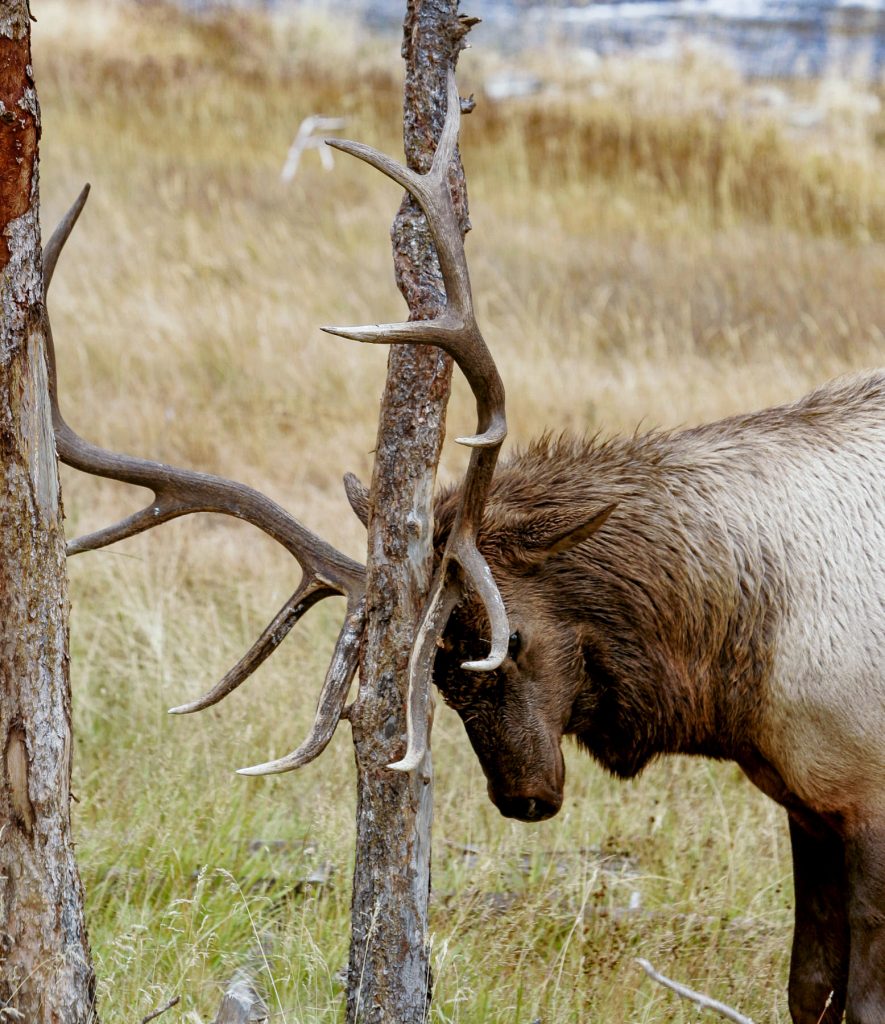
Early in the season, or in areas where bulls are getting a lot of calling pressure, raking can be used effectively as a stand-alone method for bringing bulls in close. Most of the time, however, I prefer to add raking to my calling sequences, and it is often the raking that seals the deal and brings a stubborn herd bull away from his cows. The challenges and insults from the calls are hard to ignore, but when his dominance is questioned by a challenger raking a tree, it is often too much.
Raking a tree is simple, and takes no mechanical or commercially developed gear to replicate. Simply find a decent-sized stick, and then start thrashing a small sapling or bush with it. Elk can get pretty intense when they start tearing up a tree with their antlers, so put that same intensity into your raking. Stomp the ground, break branches, and make some noise. I like to really dig the raking stick into the trunk of the tree in addition to thrashing the limbs on the tree.
Similar to calling, the closer you can get to the bull to begin raking, the better off you will be. A display of dominance at a close distance will have a much more powerful effect than it does from far away.
Click below to watch a video demonstrating how to rake a tree to bring elk in:
DECOYS
During one of my first out-of-state elk hunts several years ago, I discovered the effectiveness of another elk hunting tactic: decoys. I was hunting the open, pinion-juniper country of Arizona, and decided to bring along a decoy. I had never used a decoy prior to that hunt, but I had two good friends tagging along to lend a hand, so I armed one of them with a video camera and the other with a decoy. I have heard people say that calling elk in places like Arizona can be difficult, and to some degree, I would agree. Some units have very high bull-to-cow ratios, and that can make it difficult to get a bull – especially a herd bull – to leave his cows and come in to a static calling setup. One morning, we were following a large mass of screaming bulls up a ridge as they made their way to their bedding areas. There were cows spread out all over the ridge, and the bulls were scrambling to keep their cows separated and to ward off any intruding bulls that came too close. However, they were not interested in coming back to investigate our callings. With my call in hand, I was just another one of the intruders, and the bulls would quickly move off if I tried to get close. I was out in front, calling and moving in on the closest bugle, and Donnie was right behind me with the video camera. I motioned for Dave to pull out the decoy, and as we crested a small rock outcropping, a bull bugled from a thickly timbered ridge just 200 yards ahead. With limited cover between us and the bull, I knew more movement would be risky, but I also knew the bull wasn’t likely going to come in to our setup. I knelt down next to a dead stump as Dave crouched down and employed the decoy 30 yards behind me. I gave a few soft cow calls back in the direction of the decoy to coax the bull down off the ridge. He let out a timid bugle and slowly walked into view on the ridge. Reaching a point where he should have been able to see the source of the calling, he paused and scanned the flat. This was the point where most of our call-ins had been stalling out. The open terrain had been making it difficult to coax the elk in those final 100 yards for a shot, especially when they felt they should be able to see an elk and couldn’t. This time, as soon as the bull caught a glimpse of the decoy, he resumed his approach and came in on a string. The bull walked through multiple shooting lanes until he stopped just 25 yards from me and less than 20 yards from the decoy. At that point, he got his first clear look at the decoy and quickly turned and crashed away. Lucky for this bull, I was holding out, and he retreated back to safety. Watch the video of this call-in below:WHY DO DECOYS WORK?
Elk, like other ungulates, have decent vision. Scientists have determined their vision to be around 20/60 – not stellar, but good enough to quickly ascertain the outlines of certain objects. Elk also lack a full pallet of color receptors, which limits their ability to pick up on colors the way humans do, specifically the color red. What they lack in visual acuity, however, they make up for in their ability to detect movement.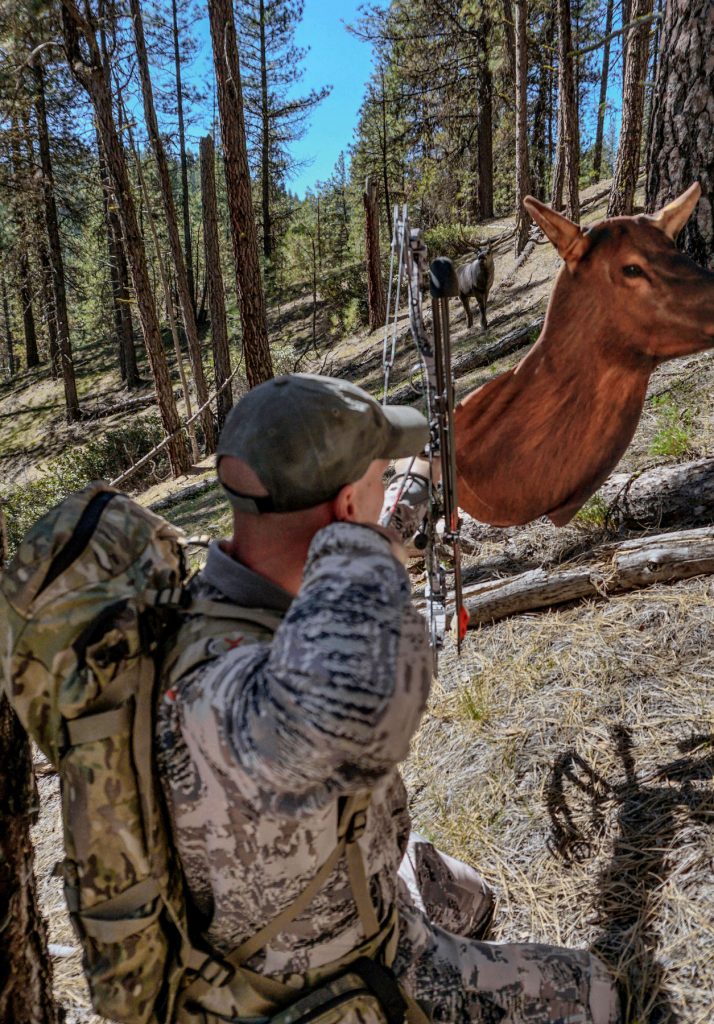
Elk have an exceptionally wide field of view, nearly two-and-a-half times wider than our 120 degree field. This gives them a keen advantage in detecting the slightest movements, even when the movement would seem to be completely out of their line of vision.
Due to the characteristics of their vision, elk use their sense of sight primarily as a secondary source of protection, and rely more on their noses and ears to keep them away from danger. If they smell or hear something, they will quickly scan their surroundings to confirm with their eyes whether it’s a threat or not. This method of visual confirmation can either be an advantage, or a disadvantage, for an elk hunter.
Perhaps the greatest obstacle an elk hunter encounters while calling elk is “the hang-up”. The elk comes in to 100 yards or so, and then stops. None of the calls you throw at him – sweet cow calls, vicious challenges, even the silent treatment – will break him loose and get him to continue his approach. Eventually, he turns and wanders back to where he came from. There is a reason elk hang up, and it isn’t their sixth sense. Most times, it’s actually their third one – vision.
Elk have an amazing ability to pinpoint sound. When we call to an elk, they can pinpoint our location with precision accuracy. When they approach that location and can’t see the source of the calling, they get nervous. A 700-800 pound animal should be visible to them at that point. If it isn’t, they aren’t likely to come any closer until they can visually confirm what their ears have led them to believe, especially if they’ve had some close calls with danger in the recent past.
CHOOSE THE RIGHT SETUP
On that memorable hunting trip in Arizona several years ago, I learned a very helpful lesson. If an elk can visually confirm the source of the sounds he’s coming in to investigate, you stand a much higher chance of bringing him closer. The likelihood of that elk stopping and hanging up outside of bow range can be greatly decreased. With that first encounter now behind us, we ventured to our next setup, excited to reproduce these results on a larger bull. What we experienced instead, left me scratching my head.
A mature-sounding bull was bugling from just inside the timber on the opposite side of a large meadow. The opening was 300 yards across, and was speckled with small junipers; enough to allow us to move part way across the meadow without concern of being detected. We slipped out through the meadow until we ran out of cover, then set up the decoy and began to call. I was set up 40 yards to the right of, and downwind from, the decoy.
The bull stepped out from the timber, bugling incessantly at our every call. He was hooked and we were reeling him in. Then, he made visual contact with the decoy. What happened next was completely unexpected based upon my previous experience. The bull didn’t come running right up to the decoy. Instead, he turned and began skating the edge of the timber, circling around 200 yards downwind of us. He stopped bugling, and was visibly cautious as he worked his way around the meadow to my right. Still 200 yards away from us, the bull stopped. He was now at a sharp angle to the decoy, and the 2D representation of another elk had suddenly lost much of its viewable surface area – and evidently, its realism and appeal. The bull turned and slowly walked back into the timber.
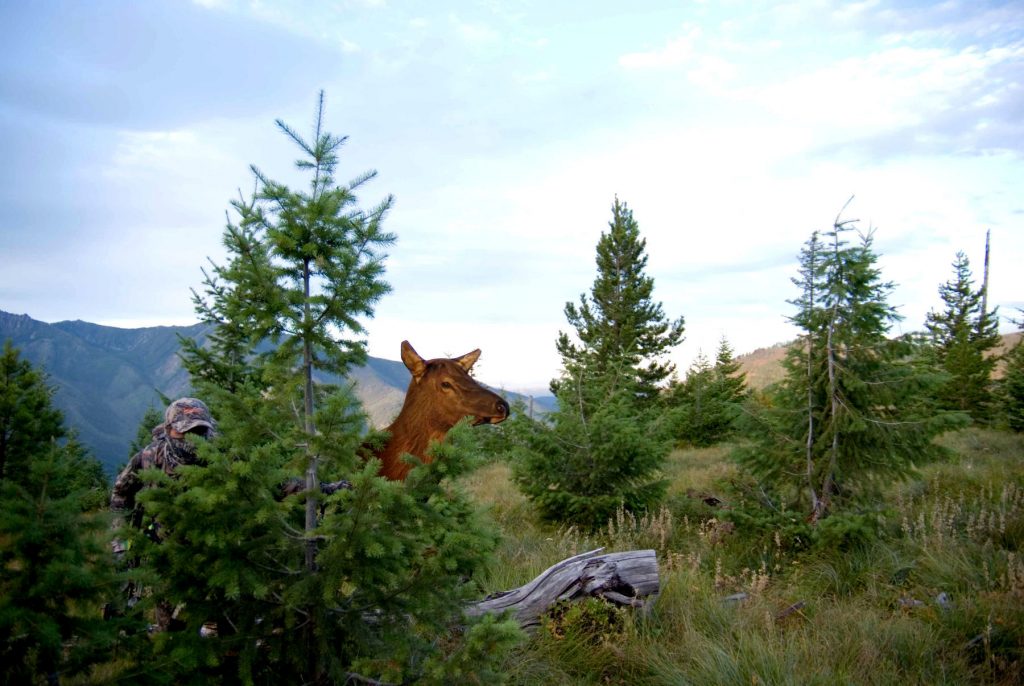
The first bull had seen the decoy and walked in on a string. The next one, however, saw it and instantly became cautious. What was the difference? In my opinion, it was our setup. In the first setup, the bull could only see bits and pieces of the decoy. It was enough to confirm there was something there he expected to see, but it wasn’t enough for him to get a good, clear look at. So, he continued his approach to get a closer look.
In the next setup, the bull was able to get a clear view from a safe distance. When the decoy didn’t respond to his presence, the bull instantly became nervous and knew something wasn’t right. Keeping a close eye on the decoy, he moved around to the downwind side where he could get a second opinion from a more reliable sense. Before he managed to catch our wind though, his eyes were able to notice something was wrong with the rapidly diminishing image of an elk in front of him, and his confidence was shattered. He left and couldn’t be convinced we were a real elk for the rest of the morning.
THREE KEYS TO USING A DECOY
Since those first experiences with decoys, I’ve had similar mixed results. There are a few things that have helped increase our effectiveness in using decoys, though. First, I’ve found it beneficial to employ calling with a decoy setup, rather than sitting silently and waiting for an elk to pass by and notice the decoy. If I blindly set up along a game trail or on the edge of a meadow or wallow without calling, I don’t use a decoy. I’ve rarely had elk approach a decoy the way a turkey approaches a static decoy simply on visual contact. Curiosity may bring them a little closer, but a full approach within bow range is highly unlikely. My experiences indicate a greater likelihood of hanging up if the elk encounters a sudden, unanticipated visitor. Calling will give them a primary sensory indicator that they can then confirm with visual evidence.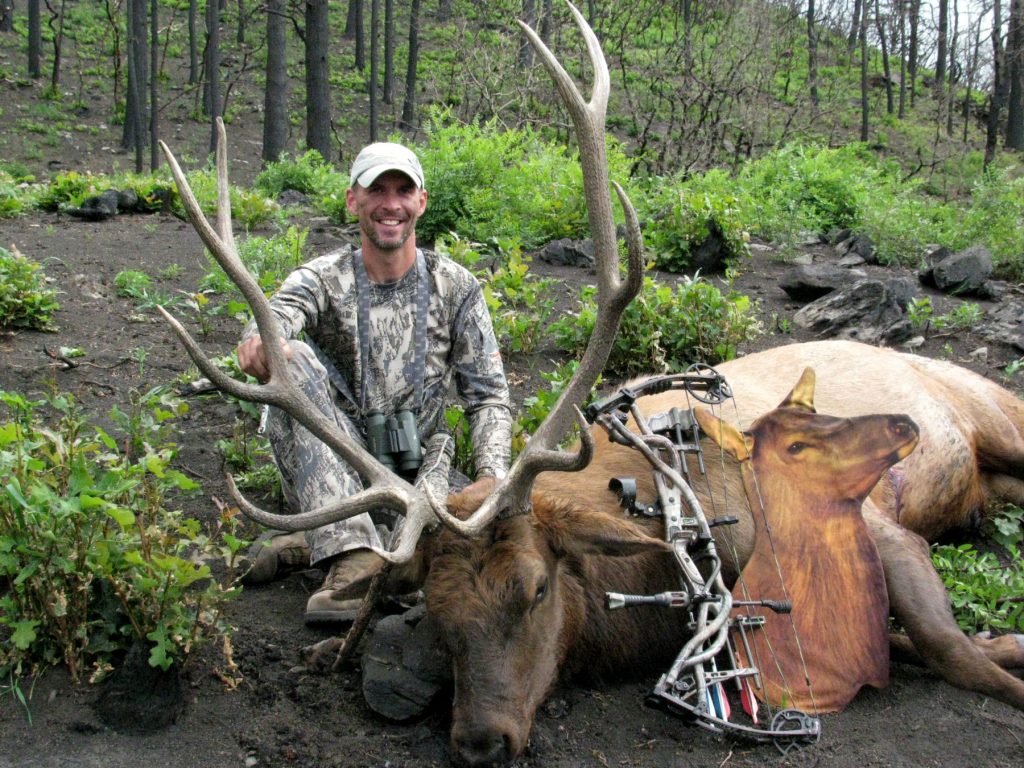
Second, don’t give elk a clear view of the decoy. If an elk can clearly see the decoy from 100 yards away, they seem to be much less likely to continue closer. I’ve found that setting up a decoy in intermittent timber or broken terrain will give the bull glimpses of the decoy as he approaches, without allowing him to stop and fully analyze what he’s seeing. If you’re set up in an area that doesn’t allow for this, “flashing” the decoy can provide the same effect. This can be done by calling to the bull as you hold the decoy up. Once he gets a momentary visual of the decoy, slowly drop it back out of sight. Again, a glimpse of the decoy will tease the bull, but not allow him a full look and an opportunity to visually study the decoy.
Finally, use the decoy as a last resort. Rather than utilizing the decoy as soon as I have an elk coming my direction, I use it as a last-ditch option to pull a stubborn bull into a setup after every other attempt has failed.
Similar to bugling when a bull is running in to a cow call – there’s no reason to give him something he isn’t asking for. If the bull is coming to my calling, I don’t usually feel it necessary to produce an additional appeal to his senses. In my experience, a bull that is already coming in when he sees a decoy has around a 50% chance of continuing closer, so I employ decoys only after my initial tactics have stalled out, or if I’ve been consistently having troubles pulling bulls in with just the calls.
In addition to coaxing elk in to a static setup, decoys can also be used to get yourself closer to the elk. Once I’ve tried everything in my bag of tricks to bring a bull into a setup, including the decoy, I’ve found some success by moving toward the bull while holding the decoy up in front of me. This success has been limited, but at that point, it’s worth a try. Sometimes, it’s enough to cover that last 10-15 yards needed for a clear shot. Decoys can also be an effective tool for calming the skeptical eyes of the cows when we find ourselves too close to the herd.
As a word of caution: decoys are designed primarily for archery hunting, and extreme caution should be taken to ensure your safety at all times when using a decoy.
STAY ON THE MOUNTAIN!
There is no doubt that the first and last hours of daylight produce more bugles and elk vocalizations than any other time of the day. However, elk are typically on the move during these hours, and calling a bull away from his moving herd can be challenging at times. If I can find a bull and/or herd that is not on the move, I feel much more confident in my ability to call the bull in. For that reason, the middle of the day is one of my favorite times to hunt during September. In fact, over 1/3 of the elk that I have shot have been shot between the hours of 10:00 a.m. and 3:00 p.m.!
Believe me, I am a huge fan of naps during elk season. However, I have found that getting in close to elk and calling bulls in increases exponentially during the middle of the day. The reason for this is simple – the cows are bedded down and not moving.
During the mornings and the evenings, the cows are generally on the move headed to and from feed/water and bedding areas. The bulls are doing their best to stay with the cows and pretend they are in charge, but the cows are usually the ones leading the movements. If you slip up behind a herd as it is moving from its feeding area towards its bedding area in the morning, the bull will get agitated at your calling and often make a few stands, but the chances of him turning around and leaving the herd to come in to your setup is actually pretty low.
I often hear hunters describe herd bulls as “bugling and running”….this is due mostly to the fact that they are aggravated at the presence of another bull, but they aren’t going to turn around and come in to do something about it. It’s not uncommon for a herd bull to follow his cows for 2-3 miles as they make their way to their bedding area, “bugling and running” the whole time. It’s not that he is necessarily running away from the challenger, but more so that he is running to keep up with his cows. Once the cows stop to bed down, the bull will stop as well, and that is the perfect setting to work the calling magic.
I prefer to stay a ways behind the herd - sometimes on an adjacent ridge to keep an errant thermal from blowing my cover – and give them time to naturally make their way back to their bedding area. If I am following them in this manner, I will give an occasional bugle to keep tabs on their locations. Or, if I know where they are bedding ahead of time, I can plan my morning hunt around showing up at the bedding area once they have had a chance to settle in. Either way, I love to slip in close to a bull’s bedding area and work my calling sequence.
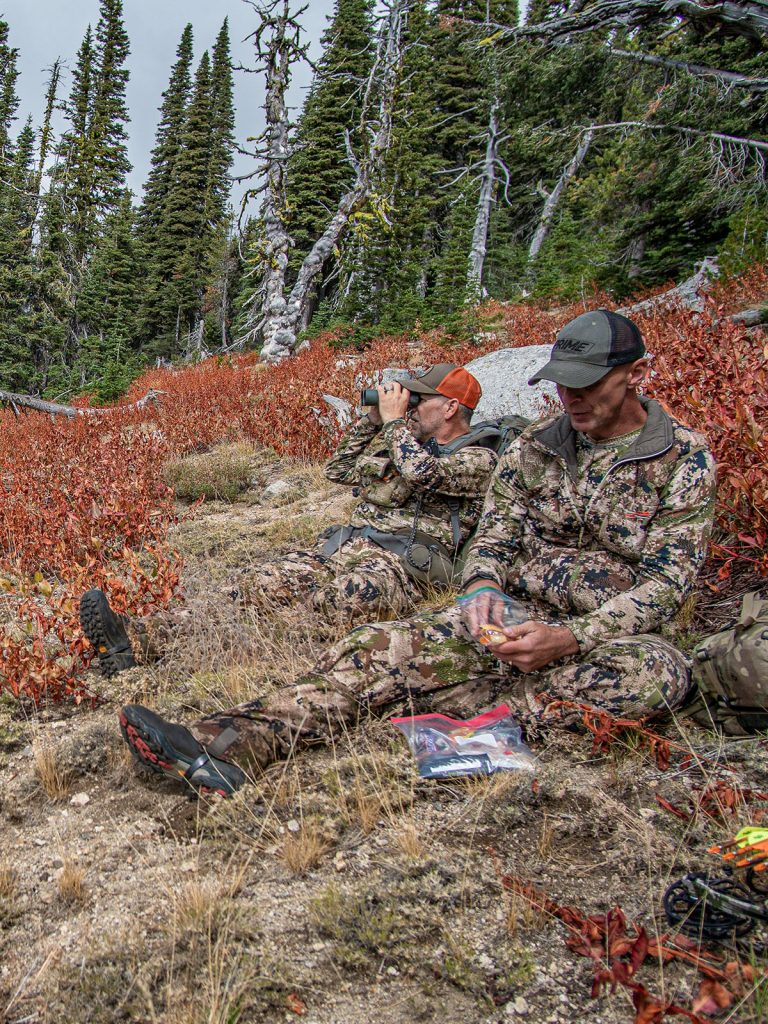
A bull elk’s emotions are magnified when he is in his bedding area. Whether it’s cow calls or bugles, if they happen in close proximity to his bedding area, the likelihood of the bull responding goes way up. Elk aren’t nearly as vocal during the middle of the day as they are bedded down, but a herd bull will usually respond to a location bugle if you are close. Sometimes, they will answer from clear across a canyon. If I find a bull bugling from his bed during the middle of the day, I get there as fast as I can. That bull can be called in and killed! Following the same script as my standard Challenge Bugle sequence, I slip in close and get set up. If you know where he is bedded (i.e., he is bugling on his own), I can just slip right in and get set up. This is my preferred tactic, as it brings with it the element of complete surprise.
Once I am set up, I give a couple soft cow calls. The bull is no longer on the move with his cows, and he is much more apt to get up and come in to investigate the lonely cow that has wandered dangerously close to his rut zone. There is really no reason for him not to get up and come check her out. A bull might try to bugle and convince the cow to make the effort to come to him, but usually a couple of persuasive cow calls will convince him to get up and come to her.
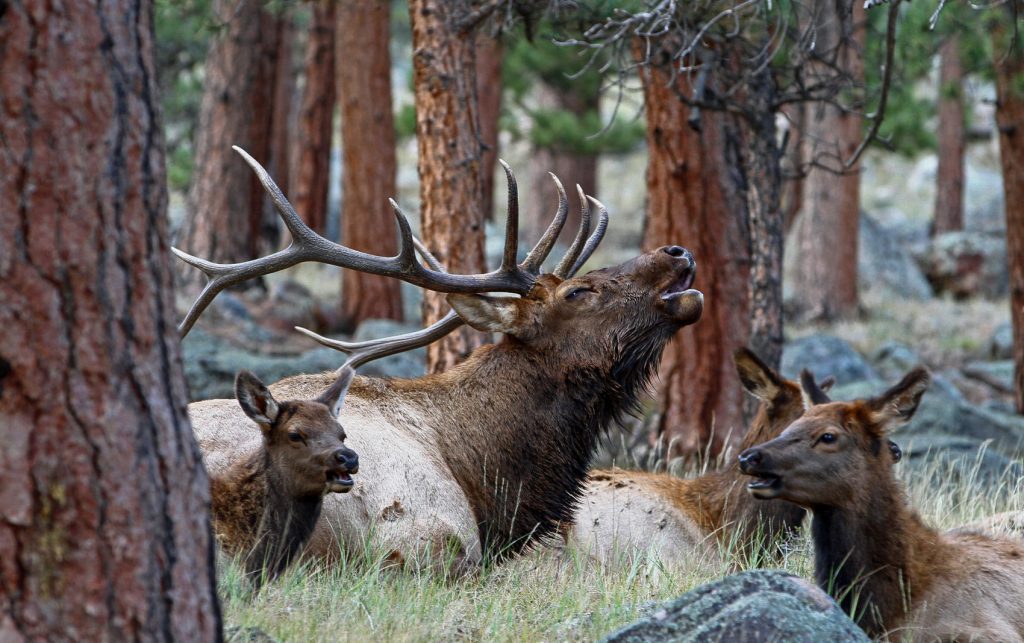
At the very least, the bull will usually bugle back to the cow calls to let her know he is there. If he doesn’t seem to be taking her advances seriously, an aggressive Challenge Bugle will likely get his full attention. In addition to the embarrassment of getting scolded for talking to another bull’s lady, we are now well inside his territory. We have walked into his bedroom and issued a threat to him in front of his harem. If the emotions he was feeling to come in and fight weren’t enough on their own, there is no longer the distraction of a moving herd to bring him to his senses. The most efficient (i.e., fast and furious) call-ins I have ever witnessed have been while calling to a herd bull in his bedding area.
I like to give the elk a solid 30-60 minutes after they have bedded down before I slip in and get the bull riled up. Every area is going to vary slightly on what time of the day the elk bed down, but I have found the time right after bedding down to be fairly effective (generally 10:00-11:00 a.m.). You will need to be there right as they are bedding down. However, the most effective time for me has been between 12:30 and 2:00 p.m.. This is prime nap-time, and many hunters are back at camp snoozing in the comforts of their camp cots. I personally prefer to get a late-morning nap on the mountain, and then move in to take care of business with the snoozing bull elk!
Many hunters have criticized this method of hunting due to the risk of blowing the elk out of their bedding area and sending them into another canyon. Due to the effectiveness of this tactic, I have found that isn’t typically a concern. I won’t go as far as to say that it is a guaranteed tactic – nothing is. But I will say that by hunting elk in their bedding areas, we have probably displaced more elk by packing them out in game bags than from bumping them out of the area… 🙂
A few years back, my hunting partner, Donnie, and I were struggling to find elk. We had relocated camp a couple of times, and were down to the last couple of days to hunt. It was mid-September, but the elk were not at all concentrated, and not very vocal. We had made a huge morning hike and were circling back down the drainage, calling sporadically, trying to get a response. We hadn’t heard a bugle all morning, and after stopping to eat some trail mix, we decided to head out and relocate once again.
About two miles from the truck, I bugled down into the canyon, and a bull answered from clear across the canyon. I looked at my watch: 12:15 p.m. I knew it would take us at least 90 minutes to scramble down our side of the canyon, and climb the steep, hot face on the other side. I wasn’t overly thrilled to head down, and I was less excited about going up the other side. The area where the bull had bugled from wasn’t a normal bedding area, and I was worried that when we got there, he might be gone. It sounded like he was calling from a bench that was about 200 yards below the ridgeline, on the hot south-facing side of the canyon. It wasn’t a likely place for a bull to lay down during the heat of the day. However, the bull bugled on his own from the same location about 5 minutes later, and without even talking it over, we were scrambling down the canyon.
It took us nearly 30 minutes to reach the bottom, and the opposite face looked even steeper from our new perspective. The thermals were moving straight up the face, so we had to be very careful to stay far enough down canyon that our thermals wouldn’t reach the bull. This required hiking a half-mile down canyon before we started our ascent.
The climb was grueling, and we hadn’t heard the bull bugle since we dropped off the other side. Before we had dropped into the canyon, I had pinpointed an old, dead tree snag that was on the main ridge, just down from where it sounded like the bull was bedded. Now, as we climbed up the hot, dry south-facing slope, nothing looked familiar. The desire to bugle was overwhelming, but I knew if I did, the bull would have the advantage and we would be caught with bad thermals and nowhere to go.
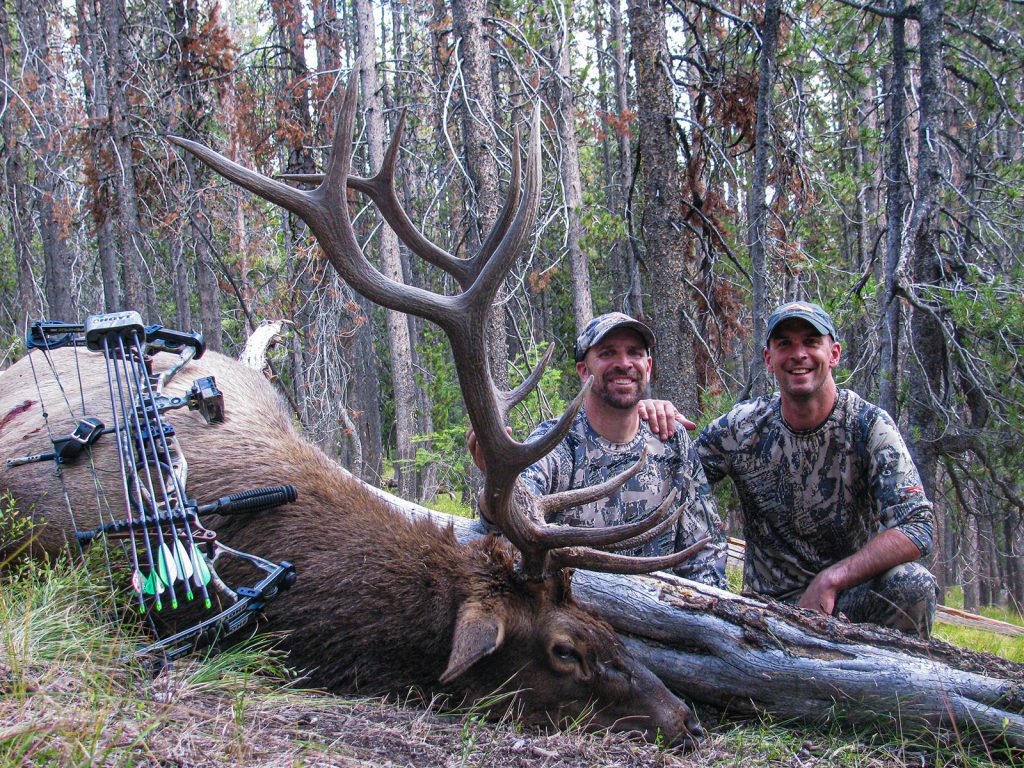
At around 2:30 p.m., we made it up to the main ridge, and began working our way along the ridge toward the bull. The thermals were moving up the ridge, but with the bull presumably bedded on the bench below us, we now had the wind in our favor. After 15 minutes of slow hiking on the ridgeline, I spotted the dead tree I had identified as a landmark. If the bull hadn’t moved, he was going to be about 200 yards up ahead and to our left. I checked the wind once more – perfect.
We slipped up the ridge another 60 yards, and Donnie found a thick patch of timber to call from. I crawled up another 40 yards, and set up. Donnie’s cow call brought an immediate response from the bull. Before the bull finished bugling, Donnie hammered him with a challenge bugle. I still had the rangefinder up to my eye, getting readings on shooting lanes, when I caught movement coming across the hillside toward me.
The bull was at 70 yards and moving straight toward me, and fast. I dropped the rangefinder and drew my bow. Within a couple seconds, the bull was standing in the primary shooting lane I had just ranged. At the shot, he ran 40 yards and piled up.
It is amazing to me how effective midday calling can be on mature bulls in their bedding areas. They aren’t usually very responsive from a distance when they’re bedded down, so locating them can be more challenging. But when you are able to locate one and close the gap, it seems they respond very favorably to aggressive calling, and usually choose to fight rather than run.
As effective as this hunting method can be to improve success with calls, there are absolutely times when calls aren't effective - either by choice or by circumstance.
Click "Next Chapter' Below to continue on to Chapter 2: Leave the Calls At Home





